
Glasgow
20 April – 7 May 2018
by DAVID GIBSON
Now in its eighth edition, Glasgow International is the largest festival for contemporary visual art in Scotland. It seeks to represent some of the most exciting work being made in the city and around the world, showcasing Glasgow as a key location for the production of contemporary art.
Under the guidance of new director Richard Parry, the festival has 40 solo exhibitions, more than 45 group shows, 268 artists from more than 30 countries showing work in 78 venues across the city, as well as more than 80 events associated with the programme, including performances, talks and screenings. The programme follows an established format comprising the director’s selection, commissioned or funded work and supported artists. The myriad range of exhibition venues are located across four quarters – City and North, West, South and East – in clusters, their satellites and faraway places. However, it is nigh impossible to see everything. Below are my selected highlights in each of the four quarters.
CITY and NORTH
The Gallery of Modern Art at Royal Exchange Square, hosts Cellular World: Cyborg-Human-Avatar-Horror, a group exhibition featuring works by nine internationally renowned artists, curated by Parry. Artists Joseph Buckley, Jamie Crewe, Jesse Darling, Cécile B Evans, Lynn Hershman-Leeson, E Jane, Sam Keogh, Mai-Thu Perrel and John Russell question how we are represented and how we represent ourselves in an age of social media. It is a popular show. Russell’s Telepath (2018) dominates, along with Buckley’s imposing Psychic Armour for Black Northerners (2017).
Ciara Phillips at Glasgow Print Studio, Trongate 103, working with GPS master printers Scott Campbell and Ian McNicol, presents Show Me Your Glow, in which she explores the possibilities of print-making in tantalising abstract and innovative ways. Meticulous and energised, she produces exquisite work that is beautiful and delightful to behold, transforming the space using an enlarged grey-scale with motifs lifted from the prints.
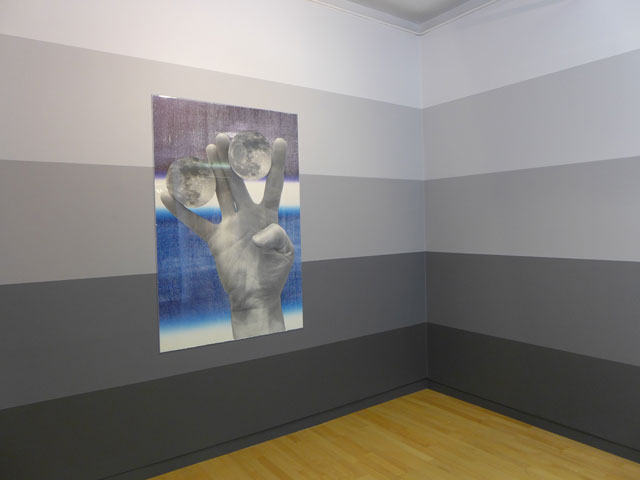
Ciara Phillips, Show Me Your Glow, installation view, Glasgow Print Studio, Trongate 103. Photograph: David Gibson.
Nnena Kalu, artist-in-residence at Project Ability, Trongate 103, has created a sculptural installation for Gi2018, binding layers of materials to form large, colourful structures that organically inhabit the gallery. Cocoon-like sculpture is produced in response to the space in a performative process addressing visitors and viewers live by internet.
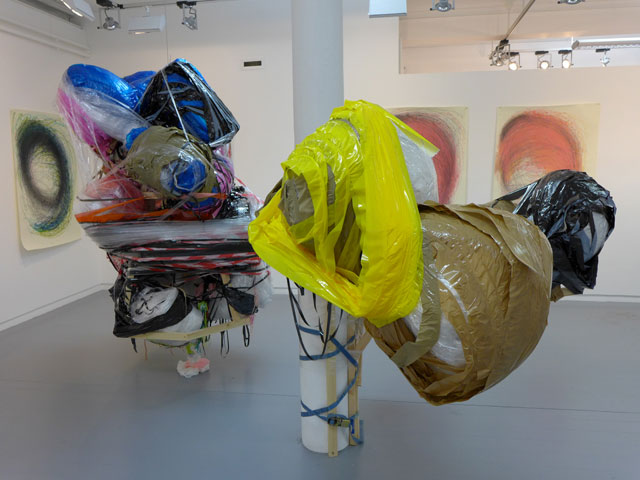
Nnena Kalu, installation view, Project Ability, Trongate 103. Photograph: David Gibson.
James Pfaff, working with curator Francesca Seravalle, at Street Level Photoworks, Trongate 103, tells a love story in Alex and Me. Pfaff asks in his artwork: “Ever been changed by someone?” The viewer must consider this exhibition as a love letter, begun 20 years ago as a road trip from Toronto to New Orleans, an intimate autobiographical account of a broken love affair between a man and a woman, which originally appeared last year as a critically acclaimed photobook.
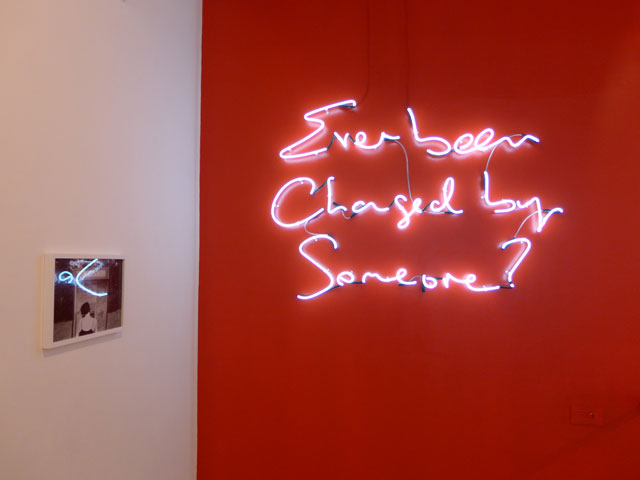
James Pfaff, Ever been changed by someone?, installation view, Street Level Photoworks, Trongate 103. Photograph: David Gibson.
Also at Trongate 103, Girlz Club is a group show including Charlotte Arnhold, Erica Eyres, Urara Tsuchiya and Ellis Luxemburg. Here, the gallery space becomes a utopian realm and an alternative reality where power lies within transformation, and where identities and aesthetics become fluid.
The Modern Institute in Osborne Street becomes the world of Duggie Fields in a historical show reimaging Fields’s personal life-work environment in Earl’s Court, London, which since 1968 has been a constant player in his output. It is an astounding installation in its depth and detail. Here, the viewer encounters “rooms” as they walk through Fields’s “actual” home and studio. The fact that Fields greeted friends and met people on the opening night made for a mind-boggling experience.
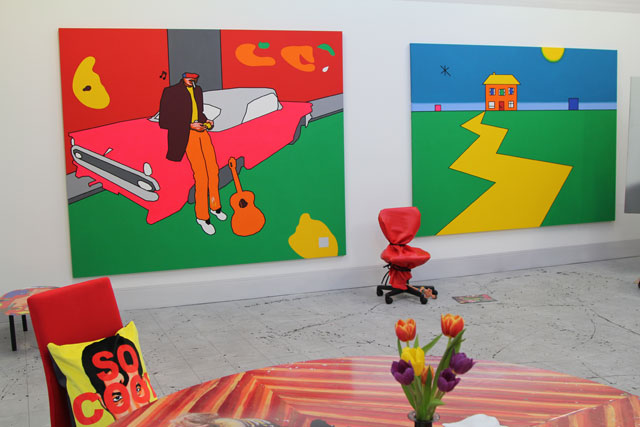
Duggie Fields, installation view, The Modern Institute, Osborne Street. Photograph: David Gibson.
The exhibition includes paintings from 1970 to 2016, alongside video and sound pieces. Such is the recreation of Fields’s personal space that the installation must be considered a total work of art.
Urs Fischer, Sol LeWitt and Nicolas Party at the Modern Institute, Aird’s Lane, offers a less is more experience. Here is to be found sculpture – large and very small pieces; including Swiss artist Party’s new major public artwork installed outside.
Work House by Corin Sworn is at Koppe Astner, Dixon Street. Sworn’s first exhibition in Scotland since 2014, it references RW Paterson’s concrete poem Room Sensed Motion, “employs” live feed surveillance cameras and “personal management technologies”. Her HD video work There is Movement (2018) occupies the main space, with two further spaces “cut away” through the gallery walls to other installed artworks.
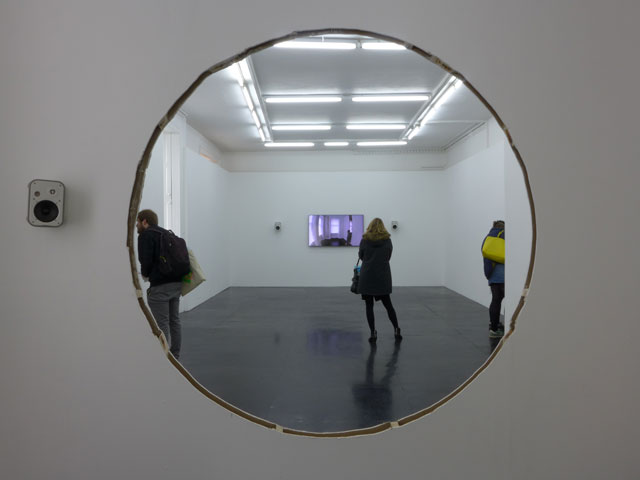
Corin Sworn, Work House, installation view at Koppe Astner, Dixon Street. Photograph: David Gibson.
In the same building, 6 Dixon Street, is Heaven to See, a group exhibition by Hamish Chapman, Andrew Sim and Paul McKee, who identify themselves as three queer Glasgow-based artists, exploring the gym, folk tales, cruising and monsters and their links to contemporary queer identity. The exhibition consists of ceramic, painting, drawing and sculpture.
Mary Mary has new gallery premises on Oswald Street, where it is presenting Core by Rose Marcus. The New York-based artist’s first UK exhibition, it comprises large multilayered works that incorporate painting, drawing, sculpture and photograph.
Glasgow Sculpture Studios in Dawson Road has created Sculpture Showroom. The idea is to identify sculptural works in long-term storage and display them with the aim of matching them with new guardians.
War of the Corners at the Glasgow School of Art, Renfrew Street, by Glasgow-based Torsten Lauschmann was two years in the making. This new solo commission of audiovisual, photographic and sculptural works is installed within three connected spaces, each linked by a facade of exposed “rustic” brickwork; actually a detailed “wallpaper” print fixed to the white walls of the Reid Building rooms. Here, old and new technologies co-exist: HD video CGI is combined with the artist’s manual metal-working craft using an old lathe forming objects for the “altars” within the large installation. Lauschmann invites the viewer to meditate here, “to feel the experience”, regardless of how brief their visit or how often they come to see it.
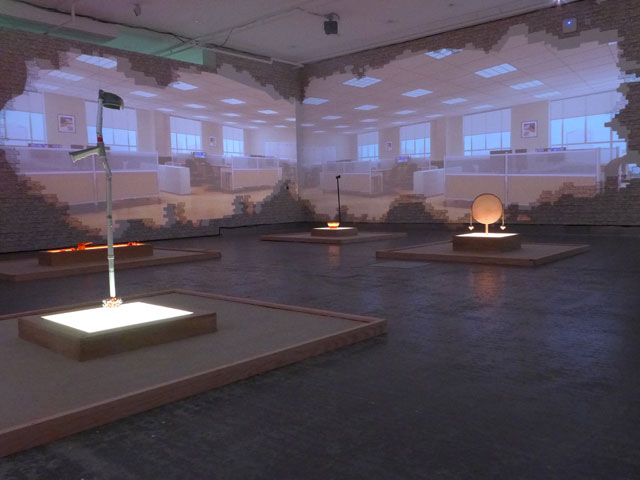
Torsten Lauschmann, War of the Corners, installation view at the Glasgow School of Art, Renfrew Street. Photograph: David Gibson.
Four automated sculptures provide movement and sound within the central space, defined by moving images that include contemporary generic office interiors, Parkour figures and clapping hands seen “against” or “behind” the digitally printed brickwork – an illusion of space, actual and virtual. The exhibition’s title is taken from a war of words that broke out in 18th-century Paris when an elitist French opera had to make way for a sudden wave of populist Italian opera. Lauschmann’s work invites the viewer to consider high and low culture, drawing together abstraction, humour, politics and art. Along with collaborators Leony Mayhew, for costume, and Jonnie Wilkes, for logotype design, Lauschmann references a world between the real and the make-believe, leaving the viewer to experience the work as how they choose to become immersed or apart from it.
Pencil to Paper by Susanne Nørregård Nielsen, also at the Glasgow School of Art, references pioneer of abstract art Sophie Taeuber-Arp and her 1922 text Remarks on Instruction in Ornamental Design. The workings for the paintings are shown in vitrines – these are drawings that could have inspired the costumed automaton in Lauschmann’s exhibition. Neilsen and Lauschmann represent the world of artist-teachers, each exploring through colour, pattern, texture and rhythm the possibilities of craft and new media.
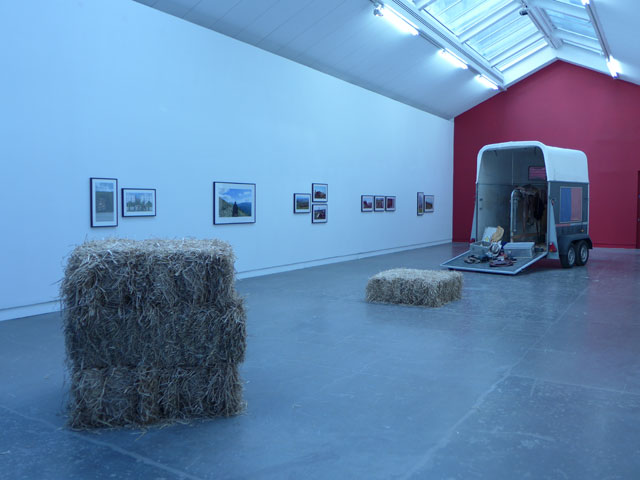
Ross Birrell, The Transit of Hermes, installation view at the Centre for Contemporary Arts, Sauchiehall Street. Photograph: David Gibson.
Ross Birrell’s The Transit of Hermes, at the Centre for Contemporary Arts, Sauchiehall Street, is outstanding in its ambition and production. This exhibition brings together major film projects originally commissioned for Documenta 14, Athens and Kassel 2017. Here at CCA, the documentation for Birrell’s epic journey is shown for the first time. Referencing Tschiffely’s Ride, an account of a 10,000-mile ride by a Swiss teacher, Aimé Félix Tschiffely, from Buenos Aires to New York in 1925 to 1928, in CCA2 Criollo invites the viewer to sit on bales of hay, employing all of their senses, to wonder at the spectacle of a magnificent Argentine horse at the gates of Central Park, New York. How did it get there? Is the solitary animal an angel, apparition or gift? Or a sign of a revolution to come? These are the questions posed by the text provided for the exhibition.
In CCA1, the bronze cast Hoof of Hermes (2018) is accompanied by The Transit of Hermes (2017). CCA3, the largest and central space, sees experienced “long riders” documented by Birrell on their marathon journey, a 3,000km horse ride from Athens to Kassel. To quote from exhibition text: “The Transit of Hermes is an exhibition that combines literal and metaphorical journeys, traversing north and south, human and animal, myth and materiality.”
Also at CCA, Raydale Dower’s Intervals is a flashback to the best gig I was never at. Inside the room is darkness, a burst of light, an instant empty stage, very loud music, darkness again, then silence. Intervals in a sound and light installation evolving continuously over 72 hours and 22 minutes on the opening weekend of Gi2018.
Transmuted Worlds at Clockwise Savoy Tower, Renfrew Street, is a group show of five women artists – Louise Gibson, Diane Edwards, Sheena Leach, Ursula Kam-Ling Cheng and Erika Stevenson. Their collective endeavour, which involved sourcing and transforming an office block that was being renovated, building the exhibition walls and installing their artworks. The women work individually and as a unit. The assembled work feels site specific, although it isn’t – possibly because Gibson’s work Lifelines (2014), with its intertwined fire hoses, resin and lacquer, draws attention outside to a recent major fire scene, and Cheng uses painted treatment to the concrete wall and floor, bringing alive her ink and acrylic work on PVC.
Also at Clockwise Savoy Tower, Material Objects is a collaborative exhibition of works by Ruth Switalski and Anthony Brotheridge, using plaster casts from the Glasgow School of Art collection. The work lies between fashion and sculpture, exploring antiquity, fabric and desire. An essay by Dr Thea Stevens of the School of Design, Glasgow School of Art, accompanies the exhibition.
The solo exhibition Black Light at The Garment Factory by Tim Head showcases large-scale digital prints. The exhibition title refers to the introduction of “blackness” to the visual spectrum blocking out the light of colour. The digitally printed works are vibrant and textural, which is fitting given that the former use of the exhibition space was for tailoring cloth. This exhibition is joyful and pure.
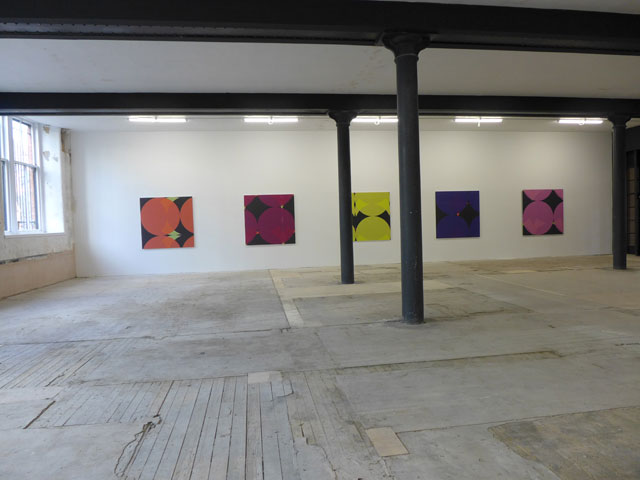
Tim Head, Black Light, installation view at The Garment Factory. Photograph: David Gibson.
Toby Paterson’s solo exhibition Penumbralism at Civic House, Civic Street, continues his exploration of leftover city spaces, modernist architecture and the “grey areas” of townscape – the spaces often overlooked or simply discarded. Paterson also has an outdoor installation at Civic Room, High Street (don’t be confused by the two venues) making manifest his articulation of derelict spaces.
WEST
At Kelvingrove Art Gallery and Museum, Lubaina Himid, last year’s Turner Prize-winner, shows commissioned work Breaking in, Breaking out, Breaking up, Breaking down. She has created a large railway carriage suspended in mid-air in the centre of the atrium, adorned by mythical creatures taken from motifs in the architecture of the space. At the opening, an organ recital of music selected by Himid was performed, including opera duets, sea shanties and classic jazz songs as seen from a female perspective. The recital ended with The Storm At Sea – an old cinema organ favourite – describing the narrative of fishermen going out to sea where they encounter a violent storm and perish. It ends with their wives singing a hymn for the souls of their loved ones.
E Jane’s Lavendra and Hardeep Pandhal’s Self-Loathing Flashmob, at Kelvin Hall, proved popular on the opening weekend. Lavendra is the name given by American artist and sound designer E Jane to a fantastical brown dwarf star, an imagined planetary cosmos “stabilised” for human presence by the harmonising influence of 1990s black pop divas including Aaliyah, Whitney Houston and Toni Braxton. A seduction of pink, purple and blue light washes over a room draped in camp pop iconography as E Jane’s diva alter ego, MHYSA performs her Afrofuturism on video screens placed across the floor.
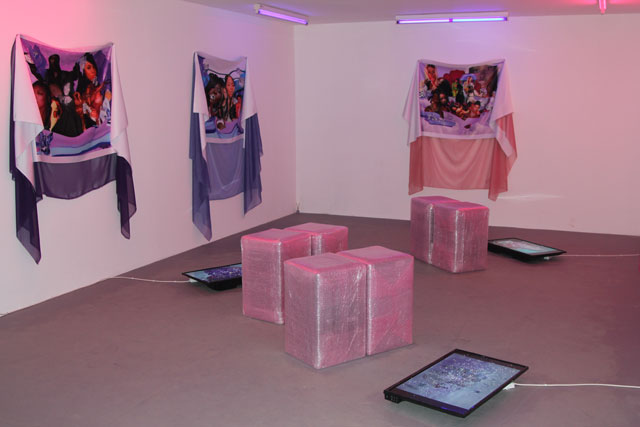
E Jane, Lavendra, installation view at Kelvin Hall. Photograph: David Gibson.
Pandhal’s work, in the ground floor foyer and upstairs ballroom, includes wall-painted and free-standing sculptures in a cartoon style. Pandhal invites viewers into his disturbing world inhabited by a motley crew of figures.
The Hunterian Art Gallery at the University of Glasgow presents an outstanding exhibition, Still Moving: The Films and Photographs of Ulrike Ottinger, which brings together photographs, films, and archive materials from the German artist spanning the period 1975 to 2016. Ottinger’s work explores the world through images notable for their curiosity about different human cultures and for their visual power and intensity.
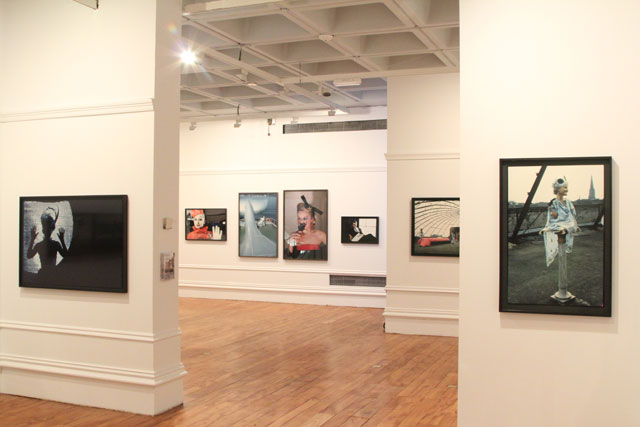
Still Moving: The Films and Photographs of Ulrike Ottinger, installation view at The Hunterian Art Gallery at the University of Glasgow. Photograph: David Gibson.
The depth of work invites prolonged investigation throughout Gi2018 and includes a mini-retrospective of Ottinger’s key feature-length film works. Photographic works, artist’s books in vitrines, a screening room for short films and an installation complete the exhibition, which is accompanied by an essay, Points of Departure, by Dominic Paterson, curator of contemporary art at the Hunterian.
The Common Guild, Woodlands Terrace, presents Radio Piombino a solo exhibition of work by Katinka Bock, her first in the UK. Bock, who was born in Germany and now lives and works in Paris, uses a range of materials, including natural substances, such as copper, lead and clay, and found or given forms. Responding to the peculiarities of the building as well as the particular history and nature of Glasgow, the galleries and stairwell within a magnificent town house are reimagined as a landscape of sculptural elements that turn the building into what Bock terms a “poisoned body”. The exhibition is accompanied by a programme of talks and events. This is an unmissable show of sculpture of the highest order.
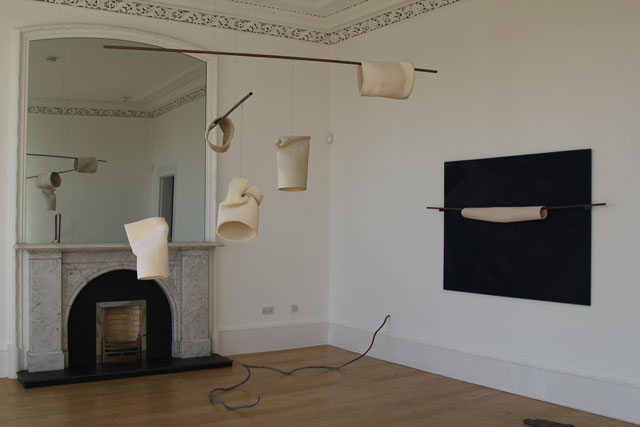
Katinka Bock, Radio Piombino, installation view at The Common Guild, Woodlands Terrace. Photograph: David Gibson.
At the Mitchell Library, North Street, the Poetry Library provides the setting for Invitation to Forms, a group show with Kate Briggs, Joseph Buckley, Francis McKee, Vivian Sky Rehberg, Sarah Tripp, Nina Wakeford and the collaborative group Brighton Upton-Trust. The exhibition is part of an ongoing research project and examines “form” in the narrative arts, based around materials curated by the writers and artists. In the library’s Glasgow Room, Anneke Kampman and Katherine MacBride have installed A Public Library Of and For Listening, which becomes a listening space where a range of experiences and encounters can take place. Visitors can drop in on the artists and interact with the work. There is an informal feel to the process and expectation that the calm and silence may change only ever so slightly, but memorably so. In the Stirling Room, The Hidden Noise present an ambitious new film installation and performance programme For Matthew by Douglas Morland, which was inspired by events surrounding the death of colliery worker Matthew Clydesdale. In 1818, Clydesdale was hanged for murder, after which surgeons attempted to resuscitate him using primitive electrical apparatus. Morland’s contemporary gothic film is based on the story, which has become part of Glasgow’s medical folklore, raising questions about the power, veracity, legibility and erasure of historical voices. The film is beautifully illuminated, interspersed with bursts of psychedelic colour.
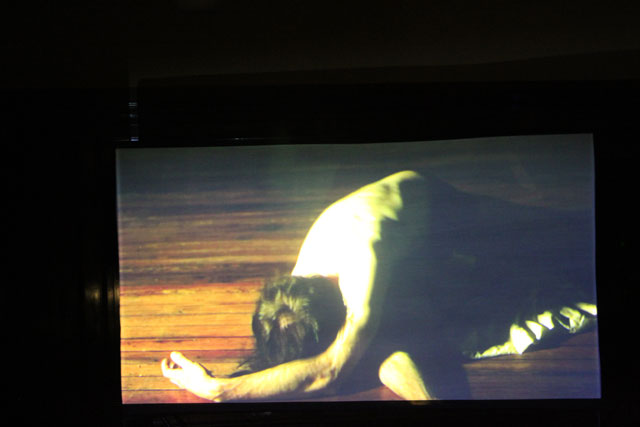
For Matthew by Douglas Morland, Stirling Room, Mitchell Library, North Street. Photograph: David Gibson.
Second Nature at 71 Houldsworth Street, is a curatorial collaboration between Home-Platform and Gossamer Fog, featuring work by Will Kendrick, Joey Holder, Lewk Wilmshurst, Eva Papamargariti, Christopher MacInnes, Samuel Capps, Diane Edwards, Ben Skea and Andrew Sunderland, which explores notions of hybrid realities, synthetic biologies and ungrounded perceptions in a post-natural world. CGI images projected on to constructed forms by Skea provide the highlight of the show.
SWG3 at Eastvale Place hosts an array of exhibitions, installations, and events. Available Nowhere assembles astonishing work by Judy Blame, the fashion stylist, art director and jewellery designer who died in February, in the form of intricate jewellery, prints and collage pieces. On the Edge of Town is the first UK show by New York-based photographer and film-maker Hugo Scott, documenting contemporary American life. Dmitri Galitzine’s At This Stage is multichannel HD video from a four-month residency at Dance Attic Studios, London. It is a mesmerising insight into the celebrated institution built from generations of performers and the dreams born and nurtured there. A collaboration between the artist Richard Wentworth and writer Victoria Miguel, A Roomful of Lovers (Glasgow) is extraordinary in scale and atmosphere.
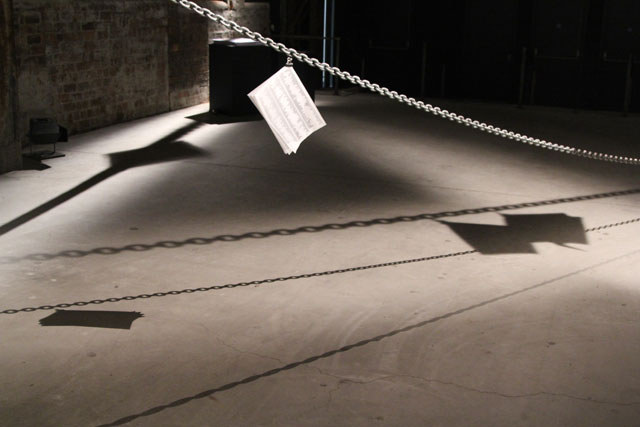
Richard Wentworth and Victoria Miguel, A Roomful of Lovers (Glasgow), installation view at SWG3, Eastvale Place. Photograph: David Gibson.
SOUTH
House for an Art Lover, Bellahouston Park, houses five exhibition and gallery spaces within the courtyard of its walled garden. Rosie O’Grady’s May Day installation conjures how artist Margaret Macdonald is represented, remodelling Macdonald’s gesso panel The May Queen as a crop circle. It is both a beautiful and brilliant work by an outstanding young talent – O’Grady is the recipient of the Gi2018 Open Glasgow Bursary.
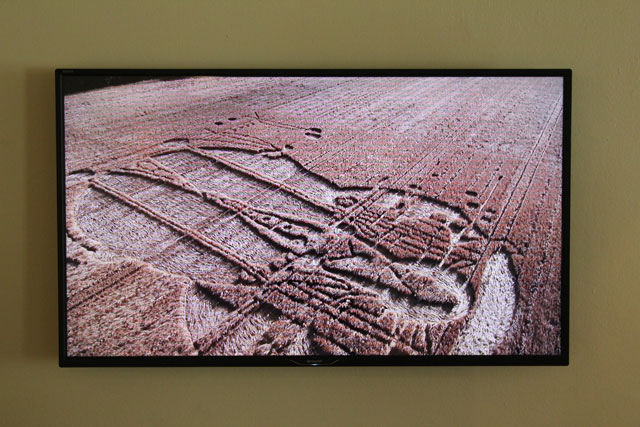
Rosie O’Grady’s May Day installation, House for an Art Lover, Bellahouston Park. Photograph: David Gibson.
In the Studio Pavilion, Paul Deslandes and Tine Bek’s As We Fall We Walk focuses on the concept of mobility and movement by exploring ideals of perfection and disconnection between body and mind. Here the photographic, film and sculptural works merge in a flawless situation.
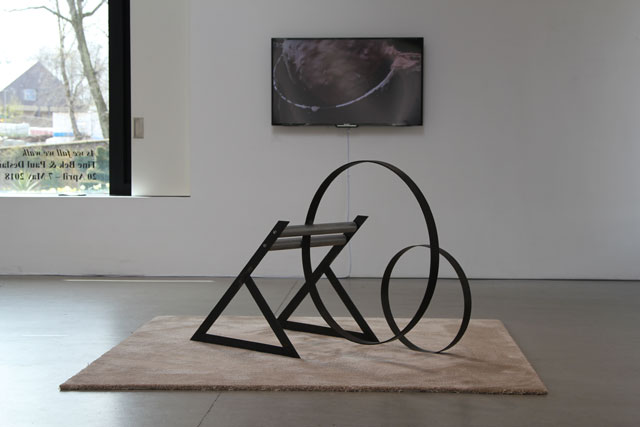
Paul Deslandes and Tine Bek’s As We Fall We Walk, installation view, House for an Art Lover, Bellahouston Park. Photograph: David Gibson.
Elsewhere, Scott Caruth’s Cazzate su Cazzate (Bullshit on Bullshit), Winnie Herbstein’s Studwork, Bahar Yürükoğlu and Alex Sarkisian’s I can’t open the can because my nails are painted can be added to the list of younger artists to keep on your radar.
Pollok House is host to Cabinet Interventions featuring Ruth Barker, Jasper Coppes, Alan Currall, Sarah Forrest, Susan Brind, Jim Harold, Shona Macnaughton, Duncan Marquiss, Shauna McMullan, and Joanna Peace. Together, the 10 artists collaborate with the National Trust for Scotland looking at how our cultural legacy is shaped. The residency- based work draws on research and dialogue presented as original sound, installation, text and performative works within and around Pollok House and estate.
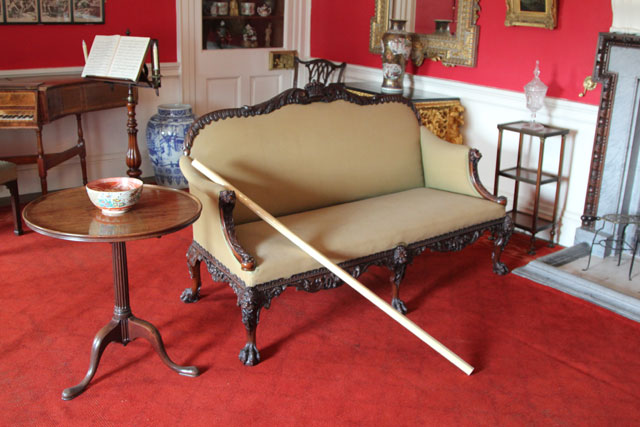
Jasper Coppes, Cabinet Interventions at Pollok House. Photograph: David Gibson.
At Queens Park Railway Club, Victoria Road, on the railway station platform, you arrive for Michael Fullerton’s Seminal Event. The viewer must imagine the works as myth “where the historical impact of Scottish Enlightenment philosopher David Hume provides a starting point for new painted works by Fullerton. Inspired by Allan Ramsay’s portrait of Hume, some the philosopher’s living relatives, many of whom now live in the USA become representations of the Scottish diaspora, their portraits a reflection on the global dissemination and influence of Hume’s philosophies.”
The Tramway, Albert Drive, needs no introduction. The former tram depot provides vast exhibition spaces inside. And outside, The Hidden Gardens are to paraphrase Ian Hamilton Finlay “an attack not a retreat”. Mark Leckey’s Nobodaddy and Kapwani Kiwanga’s Soft Measures occupy T2 and T5, respectively.
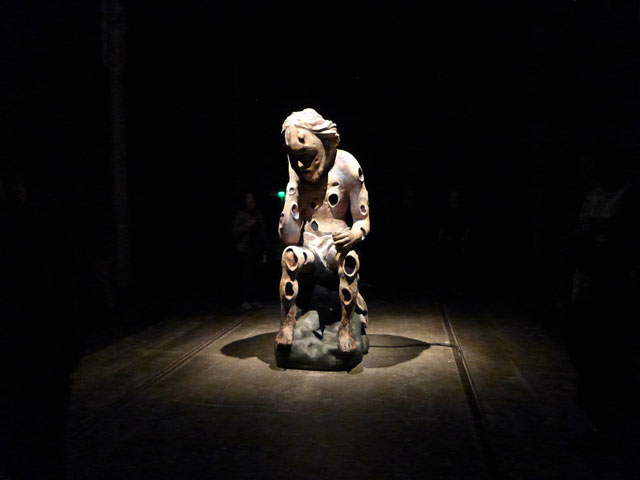
Mark Leckey, Nobodaddy, installation view at The Tramway, Albert Drive. Photograph: David Gibson.
We learn that the title Nobodaddy is taken from the poem by William Blake. An 18th-century wooden figurine of Job held at the Wellcome Collection, London, has been enlarged to human scale. This single forsaken biblical figure commands the vast space of T2. The enormous cavernous figure is represented as a narcissistic “thinker”, part statue, part cyborg, a confluence of allegories and histories that, in Leckey’s words, has become “metalized, gauzified, vegetalized and petrified, a medieval gnostic gone septic, its body now merely a thing amongst things – the spirit has departed the flesh.” Opposite the “Thinker” reflected in CGI animation with 12:1 surround sound installation, the experience of being without body and only thought is made aural and visual through the sound filling the space and the gigantic projection where the viewer may position themselves in near darkness. An eerie thought.
Kiwanga explores geological deep time and Earth’s moving tectonic plates, which are represented here by works hung on tracks, patterned fabric and stone; wall-hung sculptural reliefs arranged as obstacles or ways in which the viewer can navigate the time and movements they represent.
In the Hidden Gardens, Bone Meal is a group show featuring six Glasgow-based artists, Josée Aubin Ouellette, Jennifer Bailey, Suzanne Déry, Aideen Doran, Lauren Hall and Claire Shallcross. Using performance and writing to develop sculpture, sound and video installations, the work engages with the living and life-supporting elements of the garden. Of note is the sound piece Dressed in Flesh (2018) by Doran and the installation Time Pieces by Déry and Amy-Claire Huestis.
EAST
Mick Peter’s The Regenerators working with The Young Regenerators, a group of young visual art practitioners who produced their manifesto We will speak, You Will Listen, is located at the Dalmarnock Gas Purifier Shed. Here, Parry’s programme excels. Peter is an artist who makes playful work that investigates the symbols of power and authority using satirical and witty illustrations. For this ambitious new work, Peter, together with young people from across Greater Glasgow, has created an 80m long “billboard” to cover the empty facade of the historic former gas-purifying shed. Peering through the windows of this facade, visitors will see surprising and humorous scenes made by Peter and the young people.
Blue Pen at the David Dale Gallery, Broad Street, is a new commissioned of installation work by Lithuanian artist Augustas Serapinas, which saw him work with a company of neighbouring metal fabricators, a third-generation family business that has been in existence for more than 100 years and is landlord to the gallery. An archive and the recollections of long-serving staff members provided Serapinas with inspiration, and struck a chord with “the artist’s practice of empathetic consideration of the people who create and constitute the organisations and structures within which we work”.
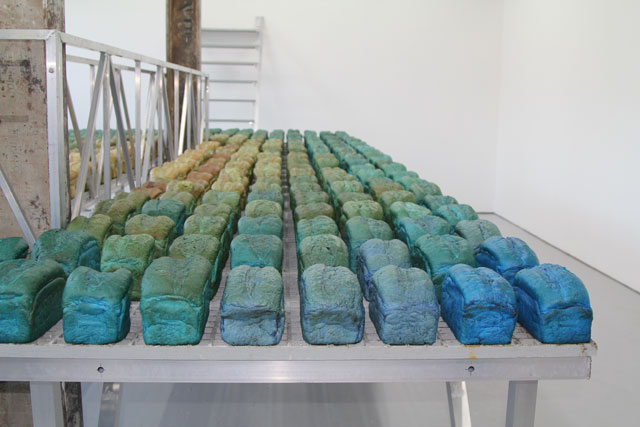
Augustas Serapinas, Blue Pen, installation view at the David Dale Gallery, Broad Street. Photograph: David Gibson.
Serapinas has engaged in the retelling of a job that went wrong – a worker on a metal platform over an industrial baker’s dough mixer accidentally dropped a pen into the dough, which resulted in 10,000 blue loaves. The story is retold through the installation to dramatic effect. Outside, the artist worked with the metal fabricators on a platform fixed to the gable wall. Look out!
The Market Gallery, Duke Street, presents Cross-feed, in which artists Aniara Omann and Gary Zhexi Zhang explore “the fluidity and contradictions between disparate systems through the use of concepts derived from consciousness-based reality, quantum physics and microbiology”. Ecologies and complex interrelations between global networks and local communities provide inspiration for this fascinating show.
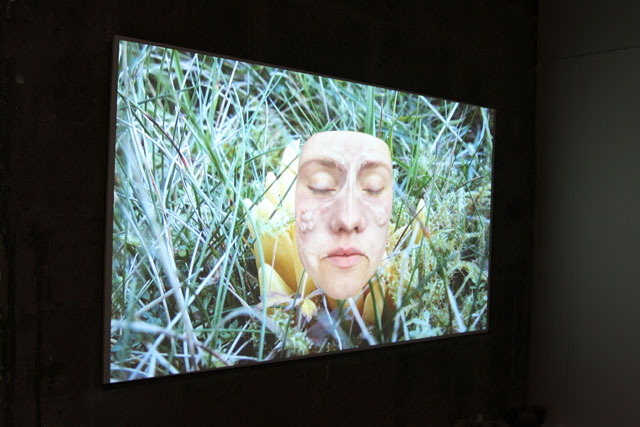
Aniara Omann, The Market Gallery, Duke Street. Photograph: David Gibson.
At Platform, Westerhouse Road, Easterhouse, the remotest Gi2018 venue, Jessica Ramm’s Personal Structures is a new body of work exploring “home-made” architecture as an aesthetic and political statement. A series of temporary structures occupies the Platform space.
In Duke Street, a new gallery, Frutta, presents Italian artist Santo Tolone’s The distance between the fridge and my belly, or rather between your eyes and this title. This inaugural solo exhibition causes visitors to do a double-take or to be amused, as Tolone has intended.
Civic Room, High Street, a former linen bank-turned-exhibition space, is hosting Against Time, a group exhibition that “explores the anachronistic condition of contemporary art and its creative potential,” according to its co-curators, Paula Zambrano and Sarah Strang. The exhibition brings together artists Toby Paterson, Geneva Sills, Sarah Forrest and Sue Tompkins. The performance piece St St Steadicam High, by Tompkins, opened the exhibition. Tompkins’ impish improvisation provided bags of enthusiasm – she bounced about, part pop star, part poet, making eye contact with her audience, inviting their reaction. She performed to a tightly packed audience, and was joyfully received in the best show-business tradition, leaving them asking for more.
Sills shows various sized silver gelatin prints, the largest of which, Dappled (2018), provided the backdrop for Tomkins’ performance. In the back room, Forrest’s Again, it objects (2016) is a single-screen HD video loop with familiar AC/DC rock guitar riff sound-tracking words … “here”, “hole”, “physical”, “stand”, “shadow”, “crawl”,”logic”. Outside, Palisades (2018) by Paterson is a blue-painted metal sculpture temporarily occupying vacant land set among the new “bland” architecture here in the former heart of the city. The commissioned site-specific work, marking a temporary place along a permanent pathway to the train station, draws attention to redevelopment and vacant land.
Gi2018 provides an enormous range of visual art, possibly too much for anyone to absorb within a festival period that lasts less than three weeks. The fact that the city is helpfully divided into four quarters allows visits to be planned to certain clusters and venues. However, visiting only some parts of the city will deny the possibility of discovering some of the best art. And visiting the Director’s Programme alone will not guarantee seeing the best on offer. Therefore, I have selected my top favourites from Gi2018 by each of the four City quarters:
City and North: Torsten Lauschmann at the Glasgow School of Art; Ross Birrell at the Centre for Contemporary Arts; and Corin Sworn at Koppe Astner.
West: Ulrike Ottinger at the Hunterian Museum; Kantinka Bock at the Common Guild; and Douglas Morland at the Mitchell Library.
South: Rosie O’Grady at House for an Art Lover.
East: Augustas Serapinas at David Dale Gallery and Studios.
Planning for Gi2020 will probably have begun already. My only quibble is that the festival deserves to last twice as long and too many of the openings are crammed into the first few days. For this review, I visited about 35 venues and 50 exhibitions over four days, which ensured I saw most of the Director’s Programme and the best of the commissioned artworks, and I discovered the “popup” and new venues in the supported programme that are always inspiring and delightful. There is much yet for me to see before Gi2018 ends on 7 May 2018.